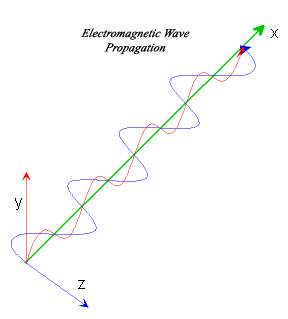مقدمه:
نظریه سی.
پی اچ. در سال 1366 (1987 م) با طرح این مسئله که سرعت
نور ثابت نیست و تابع نیروهای خارجی محیط انتشار است،
مطرح شد. در نظریه سی. پی. اچ. نیز طبق اصل نسبیت خاص
سرعت نور در تمام
دستگاه های
لخت و فضای تهی ثابت و برار c است.
اما سرعت نور در محیط انتشار تابع نیروهای خارجی است
که بر نور اعمال می شود. تجارب و دیدگاه های اخیر نشان
می دهد که پیشگویی نظریه سی. پی. اچ. در مورد تغییر
سرعت نور درست بوده است. در ادامه دو نمونه ارائه شده
است. اما در آنجا هیچگونه توجیه نظری در مورد علت
تغییر سرعت نور وجود ندارد. در حالیکه نظریه سی. پی.
اچ. بر اساس تعریف و توضیح ساختمان فوتون بنا شده است.
و بخوبی می تواند دلیل نظری تغییر سرعت نور را توضیح
دهد. در ادامه پس از ذکر نمونه های مورد بحث توضیح
نظریه سی. پی. اچ. را در مورد دلیل تغییر سرعت نور
مشاهده خواهید کرد.
Light that travels
faster than light!
A
team of researchers from the Ecole Polytechnique
F�d�rale de Lausanne (EPFL) has successfully
demonstrated, for the first time, that it is
possible to control the speed of light � both
slowing it down and speeding it up � in an optical
fiber, using off-the-shelf instrumentation in normal
environmental conditions. Their results, to be
published in the August 22 issue of Applied Physics
Letters, could have implications that range from
optical computing to the fiber-optic
telecommunications industry.
On the screen, a small
pulse shifts back and forth � just a little bit. But
this seemingly unremarkable phenomenon could have
profound technological consequences. It represents
the success of Luc Th�venaz and his fellow
researchers in the Nanophotonics and Metrology
laboratory at EPFL in controlling the speed of light
in a simple optical fiber. They were able not only
to slow light down by a factor of three from its
well � established speed c of
300 million meters per second in a vacuum, but
they've also accomplished the considerable feat of
speeding it up � making light go faster than the
speed of light.
This is not the first
time that scientists have tweaked the speed of a
light signal. Even light passing through a window or
water is slowed down a fraction as it travels
through the medium. In fact, in the right
conditions, scientists have been able to slow light
down to the speed of a bicycle, or even stop it
altogether. In 2003, a group from the University of
Rochester made an important advance by slowing down
a light signal in a room-temperature solid.
But all these methods depend on special media such
as cold gases or crystalline solids, and they only
work at certain well-defined wavelengths. With the
publication of their new method, the EPFL team, made
up of Luc Th�venaz, Miguel Gonzal�z Herraez and
Kwang-Yong Song, has raised the bar higher still.
Their all-optical technique to slow light works in
off-the-shelf optical fibers, without requiring
costly experimental set-ups or special media. They
can easily tune the speed of the light signal, thus
achieving a wide range of delays.
�This has the enormous
advantage of being a simple, inexpensive procedure
that works at any wavelength, notably at wavelengths
used in telecommunications," explains Th�venaz.
The telecommunications
industry transmits vast quantities of data via fiber
optics. Light signals race down the information
superhighway at about 186,000 miles per second. But
information cannot be processed at this speed,
because with current technology light signals cannot
be stored, routed or processed without first being
transformed into electrical signals, which work much
more slowly. If the light signal could be controlled
by light, it would be possible to route and process
optical data without the costly electrical
conversion, opening up the possibility of processing
information at the speed of light.
This is exactly what the
EPFL team has demonstrated. Using their Stimulated
Brillouin Scattering (SBS) method, the group was
able to slow a light signal down by a factor of 3.6,
creating a sort of temporary"optical memory." They
were also able to create extreme conditions in which
the light signal travelled faster than 300 million
meters a second. And even though this seems to
violate all sorts of cherished physical assumptions,
Einstein needn't move over � relativity isn't called
into question, because only a portion of the signal
is affected.
Slowing down light is
considered to be a critical step in our ability to
process information optically. The US Defense
Advanced Research Projects Agency (DARPA) considers
it so important that it has been funnelling millions
of dollars into projects such as"Applications of
Slow Light in Optical Fibers" and research on
all-optical routers. To succeed commercially, a
device that slows down light must be able to work
across a range of wavelengths, be capable of working
at high bit-rates and be reasonably compact and
inexpensive.
The EPFL team has
brought applications of slow light an important step
closer to this reality. And Th�venaz points out that
this technology could take us far beyond just
improving on current telecom applications. He
suggests that their method could be used to generate
high-performance microwave signals that could be
used in next-generation wireless communication
networks, or used to improve transmissions between
satellites. We may just be seeing the tip of the
optical iceberg.
http://actualites.epfl.ch/index.php?module=Presseinfo&func=view_com&id=288
mailto:florence.luy@epfl.ch
Light's Most Exotic Trick Yet: So Fast it Goes.
Backwards?
In the past few years, scientists have found ways to
make light go both faster and slower than its usual
speed limit, but now researchers at the University
of Rochester have published a paper today in Science
on how they've gone one step further: pushing light
into reverse. As if to defy common sense, the
backward-moving pulse of light travels faster than
light.
Confused? You're not alone.
"I've had some of the world's experts scratching
their heads over this one," says Robert Boyd, the M.
Parker Givens Professor of Optics at the University
of Rochester. "Theory predicted that we could send
light backwards, but nobody knew if the theory would
hold up or even if it could be observed in
laboratory conditions."
Boyd recently showed how he can slow down a pulse of
light to slower than an airplane, or speed it up
faster than its breakneck pace, using exotic
techniques and materials. But he's now taken what
was once just a mathematical oddity�negative
speed�and shown it working in the real world.
"It's weird stuff," says Boyd. "We sent a pulse
through an optical fiber, and before its peak even
entered the fiber, it was exiting the other end.
Through experiments we were able to see that the
pulse inside the fiber was actually moving backward,
linking the input and output pulses."
So, wouldn't Einstein shake a finger at all these
strange goings-on? After all, this seems to violate
Einstein's sacred tenet that nothing can travel
faster than the speed of light.
"Einstein said information can't travel faster than
light, and in this case, as with all fast-light
experiments, no information is truly moving faster
than light," says Boyd. "The pulse of light is
shaped like a hump with a peak and long leading and
trailing edges. The leading edge carries with it all
the information about the pulse and enters the fiber
first. By the time the peak enters the fiber, the
leading edge is already well ahead, exiting. From
the information in that leading edge, the fiber
essentially 'reconstructs' the pulse at the far end,
sending one version out the fiber, and another
backward toward the beginning of the fiber."
Boyd is already working on ways to see what will
happen if he can design a pulse without a leading
edge. Einstein says the entire faster-than-light and
reverse-light phenomena will disappear. Boyd is
eager to put Einstein to the test.
So How Does Light Go Backwards?
Boyd, along with Rochester graduate students George
M. Gehring and Aaron Schweinsberg, and
undergraduates Christopher Barsi of Manhattan
College and Natalie Kostinski of the University of
Michigan, sent a burst of laser light through an
optical fiber that had been laced with the element
erbium. As the pulse exited the laser, it was split
into two. One pulse went into the erbium fiber and
the second traveled along undisturbed as a
reference. The peak of the pulse emerged from the
other end of the fiber before the peak entered the
front of the fiber, and well ahead of the peak of
the reference pulse.
But to find out if the pulse was truly traveling
backward within the fiber, Boyd and his students had
to cut back the fiber every few inches and
re-measure the pulse peaks when they exited each
pared-back section of the fiber. By arranging that
data and playing it back in a time sequence, Boyd
was able to depict, for the first time, that the
pulse of light was moving backward within the fiber.
To understand how light's speed can be manipulated,
think of a funhouse mirror that makes you look
fatter. As you first walk by the mirror, you look
normal, but as you pass the curved portion in the
center, your reflection stretches, with the far edge
seeming to leap ahead of you (the reference walker)
for a moment. In the same way, a pulse of light
fired through special materials moves at normal
speed until it hits the substance, where it is
stretched out to reach and exit the material's other
side [See "fast light" animation].
Conversely, if the funhouse mirror were the kind
that made you look skinny, your reflection would
appear to suddenly squish together, with the leading
edge of your reflection slowing as you passed the
curved section. Similarly, a light pulse can be made
to contract and slow inside a material, exiting the
other side much later than it naturally would [See
"slow light" animation].
To visualize Boyd's reverse-traveling light pulse,
replace the mirror with a big-screen TV and video
camera. As you may have noticed when passing such a
display in an electronics store window, as you walk
past the camera, your on-screen image appears on the
far side of the TV. It walks toward you, passes you
in the middle, and continues moving in the opposite
direction until it exits the other side of the
screen.
A negative-speed pulse of light acts much the same
way. As the pulse enters the material, a second
pulse appears on the far end of the fiber and flows
backward. The reversed pulse not only propagates
backward, but it releases a forward pulse out the
far end of the fiber. In this way, the pulse that
enters the front of the fiber appears out the end
almost instantly, apparently traveling faster than
the regular speed of light. To use the TV analogy
again�it's as if you walked by the shop window, saw
your image stepping toward you from the opposite
edge of the TV screen, and that TV image of you
created a clone at that far edge, walking in the
same direction as you, several paces ahead [See
"backward light" animation].
"I know this all sounds weird, but this is the way
the world works," says Boyd.
About the University of Rochester
The University of Rochester (www.rochester.edu) is
one of the nation's leading private universities.
Located in Rochester, N.Y., the University's
environment gives students exceptional opportunities
for interdisciplinary study and close collaboration
with faculty. Its College of Arts, Sciences, and
Engineering is complemented by the Eastman School of
Music, Simon School of Business, Warner School of
Education, Laboratory for Laser Energetics, and
Schools of Medicine and Nursing.
From University
of Rochester
http://www.rochester.edu/news/show.php?id=2544
بار - رنگ و
مغناطيس-رنگ
اجازه دهيد يک نگاه جديد به رفتار الکترومغناطيسي
در ميدان گرانشي بيندازيم، اين
نگرش مي تواند در حل اين معما که
فوتون از چه ذراتي تشکيل شده، مفيد واقع گردد. همچنانکه
مي دانيم يک موج الکترومغناطيسي
از دو ميدان الکتريکي و مغناطيسي عمود بر
هم تشکيل شده
است که
با سرعت خطي برابر با سرعت نور حرکت مي کنند. شکل زير:
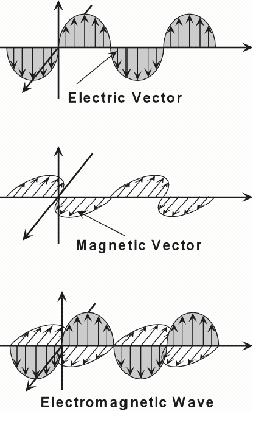
با توجه به توصيف امواج الکترومغناطيسي
و نظريه هيگز و ترکيب اين دو نظريه به نتيجه بسيار
جالبي خواهيم رسيد.
در اينجا دو ميدان داريم، يکي ميدان
الکتريکي و ديگري ميدان مغناطيسي که با توجه يه نظريه
هيگز، اين ميدانها توسط ذرات هيگز ايجاد مي شوند. اما
در اينجا ميدانها متفاوتند، يکي ميدان ابکتريکي که
توسط ذراتي ايجاد مي شوند که از خود، خواص الکتريکي
بروز مي دهند و با سرعت خطي برابر سرعت نور منتقل مي
شوند. اما علاوه بر سرعت خطي که در موج الکترومغناطيسي
دارد، روي محور عمود بر آن نيز داراي حرکت است. لذا
مجموع مسيري که اين ذرات در واحد زمان طي مي کند،
بيشتر از سرعت نور است.
در اينجا سه نکته کاملاً مشهود و قابل
تعمق است:
1 - اين ذرات خواص الکتريکي دارند. چون
به اندازه بار الکتريکي پايه (بار الکتريکي الکترون يا
پروتون) نيستند، لذا آنها را بار
-رنگ مي
ناميم. بطور مشابه در مورد ميدان مغناطيسي و ذرات
تشکيل دهنده ي آن ميتوان چنين تعبيري داشت که ميدان
مغناطيسي اطراف فوتون از مغناطيس
� رنگ تشکيل
شده است .
2 - حرکت اين ذرات را مي توان شامل سه
نوع حرکت دانست، يکي سرعت خطي که برابر سرعت انتقال
موج الکترومغناطيسي (برابر سرعت نور)، دوم سرعتي که در
ميدان دارند (در شکل بالا مشخص شده است) و سوم اسپين
اين ذرات. لذا مجموع مقادير سرعتها برابر مقدار سرعت
اين ذرات است که آن را با Vcنشان
مي دهيم. بطور وضوح مشخص است که Vc
> cکه
در آن Vc,
cبترتيب
مقدار سرعت نور و مقدار سرعت بار
� رنگ و مغناطيس
� رنگ هستند.
3 - ميدان گرانشي از ذراتي (گراويتون)
تشکيل مي شود که داراي خواص
- بار رنگي و مغناطيس � رنگي مي
باشند. زيرا همچنانکه در فصل قبل مشاهده شد، هنگاميکه
فوتون در ميدان گرانشي در حال سقوط است، انرژي و در
نتيجه شدت ميدانهاي الکتريکي و مغناطيسي آن افزايش مي
يابد (جابجايي بسمت آبي)، لذا ورود گراويتونها (بار �
رنگ و مغناطيس- رنگ) به ساختمان فوتون موجب افزايش
انرژي آن مي شود.
با توجه به اين اطلاعات به تعريف سي.
پي. اچ. پرداخته و اصل سي. پي. اچ. را بيان مي کنيم.
لازم به ذکر است که:
براي سي. پي. اچ. از کلمه ي ذره
استفاده شده است، منظور
از ذره همان نقطه ي مادي
نيست و در فارسي کلمه اي که
گوياي مفهوم سي. پي. اچ. باشد نديدم. بهمين
دليل از لغت ذره
استفاده شد.
همچنين توجه شود که در مورد شکل آن نيز هيچ نظر خاصي
وجود ندارد. لذا هر کس بنا بر برداشت و سليقه ي خود مي
تواند براي آن شکل مورد نظر خويش را تجسم کند.
CPH تعريف
فرض
کنيم يک
ذره با جرم ثابتm
وجود دارد که نسبت به هر دستگاه لختي با مقدار سرعت
ثابتVcحرکت
مي کند. وVc>c c,
is speed of light بنابراين
سي. پي. اچ. داراي
اندازه حرکت خطي برابر mVc مي
باشد. شکل زير:
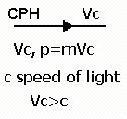
CPH اصل
پي. اچ. يک ذره بنيادي با جرم ثابت است
که با مقدار سرعت ثابت حرکت مي کند. اين ذره داري لختي
دوراني است. در هر واکنش بين اين ذره با ساير ذرات يا
نيروها در مقدار سرعت آن تغييري داده نمي شود، بطوريکه
:
gradVc=0 in all
inertial frames and any space
توجه: هنگاميکه
نيروي خارجي بر آن اعمال شود، قسمتي
از سرعت انتقالي آن به سرعت دوراني (يا بالعکس ) تبديل
مي شود، بطوريکه در مقدار Vcتغييري
داده نمي شود. يعني
اندازه حرکت خطي آن به اندازه حرکت دوراني و بالعکس
تبديل مي شود. بنابراين
مجموع انرژي
انتقالي و انرژي دوراني آن نيز همواره ثابت است. تنها
انرژي انتقالي آن به انرژي دوراني و بالعکس تبديل مي
شود.
هنگاميکه سي.
پي. اچ. داراي
حرکت
دوراني حول محوري که از
مرکز
جرم آن مي گذرد است،يعني زمانيکه سي.
پي. اچ. داراي Spin است،آن
را گراويتون مي ناميم.
When CPH has Spin, It calls Graviton
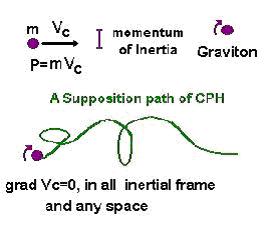
تشريح
هنگاميکه يک سي. پي. اچ. وجود
سي. پي. اچ. ديگري را احساس مي کند. داراي
اسپين مي شوند که گراويتون ناميده مي شود.
علت ايجاد اسپين در اصل موضوع سي. پي. اچ. نهفته است
که بايد با مقدار سرعت ثابت Vc حرکت
کند بطوريکه:
gradVc=0 in all
inertial frames and any space
بنابراين هر مقدار که
از سرعت آن روي يک محور مختصات کاسته مي شود، به همان
ميزان بر مقدار سرعت روي دو محور ديگر افزوده مي شود.
يعني:

بعبارت ديگر مجموع مقدار شتاب هاي سي.
پي. اچ. روي سه محور مختصات برابر با صفر است. حال دو
سي. پي. اچ. را در نظر بگيريد که متوجه بار- رنگي و
مغناطيس - رنگي يکديگر شده اند. شکل زير:
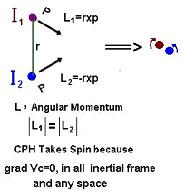
شکل بالا نشان
مي دهد که دو گراويتون با جرم mو
اندازه حرکتP
=mVc
، درفاصله rتحت
تاثير بار-رنگي و مغناطيس رنگي يکديگر قرار گرفته، با
هم ترکيب مي شوند، اما
چون مقدار سرعت آنها ثابت است، حرکت
انتقالي آنها به حرکت دوراني Spin تبديل
مي شود.
فاصله ي بين آنها تا جايي مي تواند کاهش يابد که باهم
برخورد نکنند. در صورت برخورد به دليل اسپيني که
دارند، از يکديگر دور مي شوند. لذا تراکم (چگالي) آنها
تا زماني مي تواند افزايش يابد که به حالت تماس نرسند.
در صورت تماس طي برخوردي شديد يکديگر را مي رانند و به
اطراف پراکنده مي شوند.
يکبار ديگر جابجايي بسمت آبي را به
خاطر آوريد که طي آن يک فوتون در حال سقوط در ميدان
گرانشي است. (اثر مسبوئر و آزمايش پوند - ربکا).
فوتوني با انرژي hv به
اندازه yسقوط
مي کند و انرژي آن به اندازه ي mgy افزايش
مي يابد و به مقدار hv'مي
رسد hv'=hv+mgy انرژي
و جرم فوتون افزايش ميابد. شکل زير حرکت يک فوتون در
حال سقوط در يک ميدان گرانشي را نشان مي دهد که با
ورود گراويتونها به آن انرژي (جرم)، فرکانس و شدت
ميدانهاي الکتريکي و مغناطيسي آن افزايش مي يابد.
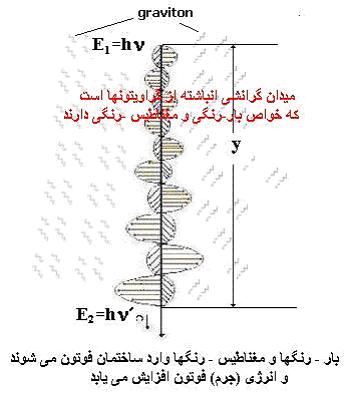
بنابراين يک فوتون
از تعدادي گراويتون تشکيل مي
شود که داراي اسپين
هستند. شکل زير:
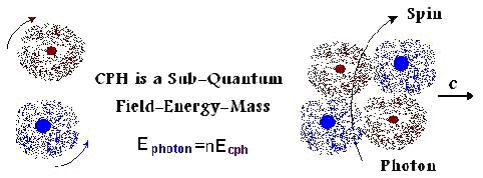
همچنين فوتون
داراي اسپين است. بنابراين
هنگاميکه فوتون با سرعت نور حرکت مي کند، گرايتون
هايي که فوتون را تشکيل داده اند داراي حرکتهاي
زير مي باشند:
حرکت انتقالي برابر سرعت نور، زيرا
فوتون با سرعت نور منتقل مي شود و اجزاي تشکيل دهنده
آن نيز الزاماً با همين سرعت
منتقل مي شوند.
حرکت دوراني (اسپين)، زيرا
طبق اصل سي. پي. اچ. مقدار سرعت سي. پي. اچ. بيشتر از
سرعت نور است و
هنگاميه سي. پي.
اچ. ها
با يکديگر ادغام مي شوند و ساير ذرات را تشکيل مي
دهند، مقداري
از سرعت انتقالي آنها به اسپين تبديل مي شود.
و حرکت ناشي از اسپين فوتون، زيرا
گراويتون ها در ساختمان فوتون هستند و
از حرکت اسپيني فوتون سهم مي برند.
زير کوانتوم انرژي،
جرم و نيرو
در فرآيند بالا نشان داده شد که چگونه
گراويتونها وارد ساختمان فوتون شده و انرژي آنرا
افزايش مي دهند. از طرفي ديگر مي دانيم که گراويتونها
حامل نيروي گرانشي هستند. لذا بسادگي مشاهده مي شود که
نيرو قابل تبديل به انرژي است. گراويتونهايي که به اين
ترتيب تبديل به انرژي مي شوند.
در يک
ميدان گرانشي، هنگاميکه فوتون بسمت آبي جابجا مي
شود، گراويتون
ها تبديل به انرژي مي شوند و
زمانيکه فوتون بسمت قرمز جابجا مي
شود، انرژي
فوتون به گراويتون تبديل مي شود و و
سرانجام با تباه شدن انرژي ، ماده و پادماده پديد مي
آيد.
شکل
زير:
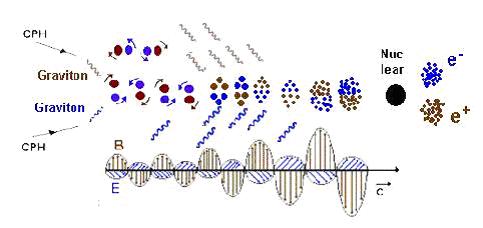
در حقيقت سي.
پي. اچ. يک زير کوانتوم هستي در طبيعت است که همه ي
ذرات از آن ساخته شده اند.
CPH is Sub
Quantum of existence in Nature
اين زير کوانتوم داراي جرم است، پس
جلوه ي ماده است، داراي
اندازه حرکت است که بيان کننده ي انرژي است. همچنين
داراي خواص
بار-رنگي و مغناطيس - رنگي است. يک
کوانتوم انرژي از تعدادي سي. پي. اچ. تشکيل مي شود و
امواج الکترومغناطيسي ظاهر مي شوند.
بدين ترتيب مشخص است که چرا نمي توان
فوتون را در حالت سکون مشاهده کرد، زير يک فوتون در
شرايط سرعت نور و از تعدادي ذرات زير فوتون (بار-رنگها
و مغناطيس-رنگها) توليد مي شود که خود اين ذرات زير
فوتوني با مقدار سرعتي بيشتر از سرعت نور حرکت مي
کنند.
بار-رنگ و مغناطيس رنگ در
امواج الکترومغناطيس معادلات
هنگامیکه یک سی. پی. اچ.
وجود سی. پی. اچ. دیگری را احساس می کند، آنها دارای
اسپین می شوند که گراویتون نامیده می شود. یک گراویتون
نظیر نیروی الکتریکی رفتار می کند و گراویتون دیگر
نظیر نیروی مغناطیسی رفتار می کند، بهمین دلیل
میدانهای الکتریکی و مغناطیسی ظاهر می شود.
شکل زیر نشان
می دهد که دو گراویتون با جرم m
و اندازه حرکت p=mVC در فاصله ی r , یکدیگر
را حس کرده و یکدیگر را جذب می کنند. اما چون مقدار
سرعت آنها ثابت است، حرکت انتقالی آنها به حرکت دورانی
Spin تبدیل می شود. هنگامیکه
سی. پی. اچ. دارای اسپین، بصورت بار-رنگ یا
مغناطیس-رنگ ظاهر می شود. در واقع گراویتون به دلیل
آنکه دارای اسپین است به یکی از دو صورت بار-رنگ یا
مغناطیس-رنگ وجود دارد.
سی. پی. اچ. ها هنگامی یکدیگر را حس می کنند که با
یکدیگر تماس بگیرند (برخورد کنند که در اینصورت به
دلیل اسپین یکدیگر را می رانند) یا در فاصله بسیار کمی
از یکدیگر باشند نظیر فاصله ای به اندازه ی طول پلانک
که تقریباً برابر است با
( Plank Length that is equal 1.6x10-35 m) در
چنین حالتی بار-رنگ/مغناطیس رنگ آنها روی یکدیگر اثر
کرده و یکدیگر را جذب می کنند. شکل زیر

بار-رنگ
و مغناطیس- رنگ
با توجه به اصا سی. پی.
اچ. و می توان نوشت:
gradVc=0
=> axi+ayj+azk=0,
that ax is
accelerating on x axes, ay is
accelerating on y axes, az is
accelerating on z axes and i,
j and k are
unit vectors.
یعنی مجموع شتاب ها
روی سه محور برابر صفر است.
فرض
کنیم که سی پی. اچ. روی محور حرکت انتقالی دارد.
ما سرعت امواج الکترومغناطیسی برابر c نسبت
به دستگاه لخت می باشد. شکل زیر
بنابراین مقدار سرعت
آن تنها روی محور های
y and z تغییر
می کند و شتاب روی محور x صفر است، یعنی ax=0 تنها
شتاب روی دو محور دیگر خواهد داشت بطوریکه ay+az=0 هنگامیکه:
ay→ 0
=> az→ maximum.
And ay→ maximum=>
az→ 0
یکی از سی. پی. اچ.
ها به بار-رنگ تبدیل می شود و و برای آن می توان
تابع بصورت زیر نوشت:
که در آن Ec مقدار
بار-رنگ است و Ecm مقدار
مازیمم بار-رنگ است. برای
سی. پی. اچ. دیگر که به مغناطیس-رنگ تبدیل می شود
می توان نوشت:
که در آن Bc مقدار
مغناطیس-رنگ است و Bcm مقدار
ماکزیمم مغناطیس رنگ است. شکل زیر
و برای سی.
پی. اچ. اختیاری داریم:
هنگامیکه یک فوتون
در حال سقوط در یک میدان گرانشی است، تعداد n افزایش
می یابد. بنابراین شدت میدانهای الکتریکی و
مغناطیسی یعنی E
and B افزایش
می یابد. و این به معنی آن است که تعدادی سی. پی.
اچ. وارد ساختمان فوتون می شوند. یک
ذره ی باردار چگ.نه امواج الکترومغناطیسی منتشر می
کند؟
همچنانکه
می دانیم یک ذره باردار که شتاب داشته باشد، امواج
الکترومغناطیسی منتشر می کند. هنگامیکه نیرویی روی
ذره ی بار دار کار مثبت انجام دهد، یعنی تعدادی
سی. پی. اچ. وارد ساختمان الکترون می شود. در
حقیقت نیرو به انرژی تبدیل می شود و به عبارت دیگر
بوزونها به انرژس تبدیل می شوند. شکل 10
اما یک ذره ی باردار
می خواهد خواص ذاتی خود را حفظ کند. یک ذره ی
باردار از تعدادی بار-رنگ تشکیل می شود، در حالیکه
انرژی الکترومغناطیسی از دو شیئی متفاوت یعنی
بار-رنگ و مغناطیس-رنگ تشکیل می شود. بهمین دلیل
ذره باردار انرژی منتشر می کند.
فرض کنيم دو سي.
پي. اچ. نسبت
به يک دستگاه لخت با
سرعت خطي Vcحرکت
مي کنند که به
دليل خواص بار-رنگي و مغناطيس - رنگي با يکديگر ترکيب
شده و فوتون توليد مي شود. چون gradVc=0 داراي
اسپين خواهند شد و مي توان نوشت:
gradVc=0 => axi+ayj+azk=0
يعني مجموع
شتاب ها روي سه محور برابر صفر است.
فرض کنيم که سي
پي. اچ. (
در پرتو الکترومغناطيسي) روي محور xحرکت
انتقالي برابر
با سرعت امواج الکترومغناطيسي(سرعت نور) دارد.
شکل زير
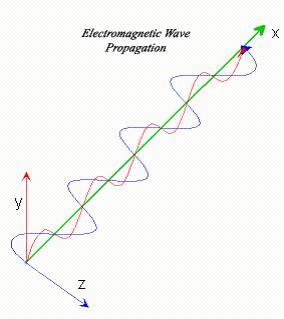
بنابراين مقدار سرعت آن تنها روي محور
هاي y,
zتغيير
مي کند و شتاب روي محور x صفر
است،يعني ax=0 تنها روي
دو محور ديگر شتاب خواهد داشت بطوريکه:
ayj+azk=0
هنگاميکه:
ay→0
→az → maximum.
And ay → maximum
when az→0
فرض کنيم يک بار- رنگ در ساختمان فوتون
همراه با يک پرتو الکترومغناطيسي روي محو ر yدر
حرکت است. اين بار-رنگ تحت تاثير ميدان مغناطيسي موجود
(مغناطيس-رنگها) دائماً در حال شتاب روي اين محور است.
بهمين دليل اسپين بار-رنگها دائماً در حال تغيير است و
اين تغييرات از مقدار سرعت آنها روي همين محور تامين و
تبديل مي شود. با افزايش اسپين، از مقدار سرعت روي
محور yکاهش
مي يابد و با کاهش اسپين بر مقدار سرعت روي همين محور
افزوده مي شود و در صورتي که شدت ميدان گرانشي ثابت
باشد، مانند فضاي بين ستارگان، سرعت نور ثابت خواهد
ماند. بهمين دليل مشاهده مي کنيم که همانطور که نسبيت
خاص تصريح کرده، مقدار سرعت نور در فضاي تهي نسبت به
همه ي دستگاه هاي لخت ثابت و برابر Cاست.
به همين ترتيب حرکت و اسپين مغناطيس - رنگها
روي محور Z قابل
توجيه است. توجه شود که اين تغييرات در در مورد بار- رنگها
و مغناطيس - رنگها
هماهنگ هستند. اگر به شکل انتشار امواج الکترومغناطيسي
توجه فرماييد، مشاهده خواهيد کرد که هم زمان دامنه ي
ميدانهاي الکتريکي و مغناطيسي ماکزيمم و صفر مي شوند.
سرعت نور
با توجه به
مطالب بالا و بار-رنگها و مغناطیس-رنگها که سازنده ی
فوتون هستند، سرعت نور تابع سرعت انتقالی اجزای سازنده
فوتونهاست. لذا هنگامیکه فوتون در میدان گرانشی در حال
سقوط است، قسمتی از حرکت اسپینی بار-رنگها و
مغناطیس-رنگها به حرکت انتقالی تبدیل می شود و سرعت
نور افزایش می یابد و در مورد کاهش سرعت نور روند عکس
انجام می شود.
|

